GWR 4900 Class
The Great Western Railway 4900 Class or Hall Class is a class of 4-6-0 mixed traffic steam locomotives designed by Charles Collett for the Great Western Railway. A total of 259 were built at Swindon Works, numbered 4900–4999, 5900–5999 and 6900–6958. The LMS Stanier Class 5 4-6-0 and LNER Thompson Class B1 both drew heavily on design features of the Hall Class. After nationalisation in 1948, British Railways gave them the power classification 5MT.
| GWR 4900 Class | |||||||||||||||||||||||||||||||||||||||||||||||||||
|---|---|---|---|---|---|---|---|---|---|---|---|---|---|---|---|---|---|---|---|---|---|---|---|---|---|---|---|---|---|---|---|---|---|---|---|---|---|---|---|---|---|---|---|---|---|---|---|---|---|---|---|
 5976 Ashwicke Hall at Exeter St David's MPD in 1953 | |||||||||||||||||||||||||||||||||||||||||||||||||||
| |||||||||||||||||||||||||||||||||||||||||||||||||||
| |||||||||||||||||||||||||||||||||||||||||||||||||||
| |||||||||||||||||||||||||||||||||||||||||||||||||||
| |||||||||||||||||||||||||||||||||||||||||||||||||||
Background
By the end of 1923 the Great Western Railway (GWR) was well served with express passenger locomotives of the Saint and Star classes and had recently introduced the Castle Class. However the mixed traffic 2-6-0 locomotives of the 4300 Class were beginning to struggle with the increasing loads. George Jackson Churchward had recognised this with the introduction of the 4700 class 2-8-0 with 5 ft 8 in (1.727 m) driving wheels, intended for express goods and relief passenger trains. However, Charles Collett preferred the idea of a Saint Class with smaller wheels to undertake these duties as this would provide a leading bogie. He therefore rebuilt number 2925 Saint Martin with 6 ft (1.829 m) driving wheels.[1]
Prototype
The prototype of the new class was rebuilt in 1924 and the cylinders were realigned in relation to the driving axle and a more modern 'Castle'-type cab was fitted. Saint Martin emerged from Swindon Works in 1924 and embarked on three years of trials. During this period Collett introduced other modifications such a changing the pitch of the taper boiler and adding outside steam pipes.
Production
After extensive trials during 1925-1927, Collett was satisfied with the performance of his prototype, subject to minor amendments and placed an order for eighty more with Swindon works (Lot 254) in 1928. The prototype was renumbered 4900 in December 1928 and the new locomotives were numbered 4901-80 and appeared at regular intervals until February 1930.[2] They were named after English and Welsh country houses with 'Hall' in their titles and so became known as the 'Hall Class'.[3]
They differed little from the prototype; the bogie wheel diameter had been reduced by two inches from 3 ft 2 in (0.965 m) to 3 ft 0 in (0.914 m) and the valve setting amended to give an increased travel of 7.5 in (191 mm). The overall weight of the locomotive had increased by 2 long tons 10 cwt (5,600 lb or 2.5 t) to 75 long tons 0 cwt (168,000 lb or 76.2 t) but a tractive effort of 27,275 lbf (121.33 kN) compared favourably with the 24,935 lbf (110.92 kN) of the 'Saint'. The original locomotives were built with Churchward 3,500 imp gal (16,000 l; 4,200 US gal) tenders but after 4958 Collett's larger 4,000 imp gal (18,000 l; 4,800 US gal) types became standard although a few later locomotives were fitted with smaller tenders if these were available as they entered service.[4]
The first fourteen examples were despatched to the arduous proving grounds of the Cornish Main Line. They were so successful here and elsewhere on the GWR system that by the time the first production batch had been completed a further twenty were on order (Lot 268, 4981-99 and 5900). Further orders followed throughout the 1930s and early 1940s. By 1935, 150 were in service and the 259th and last Hall, No. 6958 Oxburgh Hall, was delivered in 1943. Thereafter further deliveries were of the '6959 Modified Hall' class.
Oil firing
Eleven Hall class locomotives were converted to oil-firing in the period 1946–1950. While in this condition they were renumbered into the 3900 series. When the oil-firing was removed, they reverted to their old numbers.[5]
Performance
As indicated by their continuing production, the Hall class proved to be very successful in a variety of different roles, although barred from several cross-country and branch lines because of their red weight classification. According to Peter Herring, 'they were the first true mixed traffic locomotives, and as such precursors of the Stanier 'Black Five', Thompson B1 and BR Standard 5MT 4-6-0.'[6] (However, while they were forerunners of these highly successful and numerous 4-6-0 types, there were several successful 2-6-0 and 4-6-0 ‘mixed traffic’ types on the GWR and other British railways before them,[7] - not least the GWR 4300 Class they were designed to replace.[8])
Modified Hall Class
Although the GWR had been at the forefront of British locomotive development between 1900 and 1930, the 1930s saw a degree of complacency at Swindon reflected in the fact that the design had largely originated in the 1900s and had not fundamentally changed since the mid 1920s.[9] Collett was replaced by Frederick Hawksworth in 1941 who created a modified version of the design, known as the Modified Hall Class. These continued to be produced by British Railways until 1950, by which time there were a further seventy-one locomotives.
Accidents and incidents
- On 30 April 1941, 4911 Bowden Hall took a direct hit during a bombing raid on the Keyham area of Plymouth and was later broken up.[10] The locomotive had stopped at a signal box because of an air raid, and the crew survived by sheltering under the steps of the signal box.[11] 4911 was one of two GWR locomotives damaged beyond repair in Britain during World War II, the other was GWR 1854 Class No. 1729. 4936 Kinlet Hall, ran into a bomb crater in that area and was severely damaged, but was repaired.[12]
- On 13 February 1961, 6949 Haberfield Hall was in collision with a freight train that was being shunted at Baschurch, due to a signalman's error. Three people were killed and two were injured.[13]
- On 25 August 1962, a passenger train stopped at Torquay, due to the failure of the locomotive hauling it. 4932 Hatherton Hall was hauling a passenger train that overran signals and was in a rear-end collision with it. Twenty-three people were injured.[14]
Withdrawal
All but one of the original Collett Halls survived until nationalisation in 1948, the exception being 4911 Bowden Hall. Withdrawals began in 1959 with the prototype Saint Martin. Its accumulated mileage, both in its original form and rebuilt form, was a remarkable 2,092,500 miles. Further withdrawals of the production series took place during the 1960s and the class was extinct by 1965.
Preservation
By 1965 the last Hall had been withdrawn from the Western Region without a single one entering the National Collection. Eleven examples of the Hall class have survived to preservation with all being rescued from Barry Island Scrapyard, seven of which have run in preservation. Of the engines which haven't yet operated in preservation, 4942 Maindy Hall has been "regressed" back to a GWR Saint Class, 4979 Wootton Hall is undergoing restoration at the Ribble Steam Railway with work currently focusing on the engine's tender, 5952 Cogan Hall is awaiting restoration at the Llangollen Railway with a small number of parts being used in the construction of 6880 Betton Grange and 5967 Bickmarsh Hall is undergoing restoration at the Northampton & Lamport Railway.
Of the remaining seven Halls which have run in preservation, six have been operated on the main line: 4930 Hagley Hall, 4936 Kinlet Hall, 4953 Pitchford Hall, 4965 Rood Ashton Hall, 5900 Hinderton Hall and 5972 Olton Hall. 5972 Olton Hall has gained fame as the locomotive used in the Harry Potter film series.
In January 2020 no Halls were operational on the main line. 4936 Kinlet Hall is undergoing a Network Rail standard overhaul at Tyseley Locomotive Works.
| Number | Name | Image | Built | Withdrawn | Owner | Base | Status | Livery | Mainline Certified | Notes |
|---|---|---|---|---|---|---|---|---|---|---|
| 4920 | Dumbleton Hall |  |
March 1929 | December 1965 | Private Owner | South Devon Railway | Stored | GWR Lined Green, GW Lettering | No | operational 1992-1999[15] Sold from SDR to new owner in December 2020.[16] |
| 4930 | Hagley Hall | 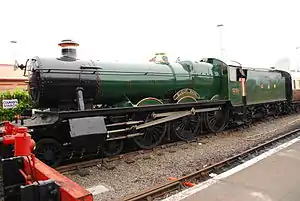 |
May 1929 | December 1963 | Severn Valley Railway | Severn Valley Railway | Undergoing overhaul | No | ||
| 4936 | Kinlet Hall | .jpg.webp) |
June 1929 | January 1964 | West Somerset Railway | Tyseley Locomotive Works. | Undergoing overhaul | BR Lined Green, Late Crest (on completion) | No (to be certified) | |
| 4942 | Maindy Hall | 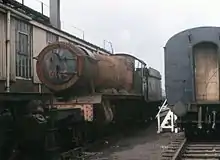 |
July 1929 | December 1963 | Didcot Railway Centre | Didcot Railway Centre | Operational | GWR Lined Green, Great Western Lettering | No | Rebuilt into GWR 2900 Class no 2999 Lady of Legend |
| 4953 | Pitchford Hall | 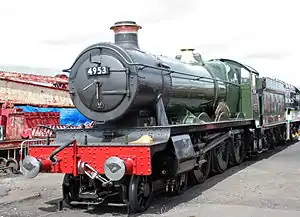 |
August 1929 | May 1963 | Epping Ongar Railway | Epping Ongar Railway | Operational | BR Lined Black, Early Emblem | No | Returned to traffic in December 2019. |
| 4965 | Rood Ashton Hall |  |
November 1930 | March 1962 | Vintage Trains | Tyseley Locomotive Works | Awaiting overhaul | GWR Lined Green, Great Western Lettering | No (to be certified) | Used parts from 4983 Albert Hall, and was named Albert Hall on one side when entered service in preservation[17] main line certified 1999-2019 |
| 4979 | Wootton Hall | 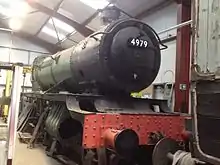 |
February 1930 | December 1963 | Furness Railway Trust | Ribble Steam Railway | Undergoing restoration | No | ||
| 5900 | Hinderton Hall |  |
March 1931 | December 1963 | Didcot Railway Centre | Didcot Railway Centre | Static display | GWR Lined Green, Great Western Lettering | No | Was used in the 1970s to haul nine vintage ex-GWR carriages on the main line from Didcot.[18] |
| 5952 | Cogan Hall | 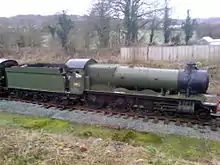 |
December 1935 | June 1964 | Betton Grange Society | Llangollen Railway | Stored | No | Tender and other minor parts used on 6880 Betton Grange. Restoration to commence following the completion of 6880. | |
| 5967 | Bickmarsh Hall |  |
March 1937 | June 1964 | Nortampton & Lamport Railway | Northampton & Lamport Railway | Under restoration | No | ||
| 5972 | Olton Hall |  |
April 1937 | December 1963 | West Coast Railways | Warner Brothers Studio Tours | Static display | Hogwarts Railway's Crimson, Hogwarts Railway's Crest | No | Used in the Harry Potter films, renamed Hogwarts Castle for filming |
References
- le Fleming, H.M. (November 1960) [1953]. White, D.E. (ed.). The Locomotives of the Great Western Railway, part eight: Modern Passenger Classes (2nd ed.). Kenilworth: RCTS. pp. H29.
- le Fleming, H.M. (November 1960) [1953]. White, D.E. (ed.). The Locomotives of the Great Western Railway, part eight: Modern Passenger Classes (2nd ed.). Kenilworth: RCTS. pp. H29.
- Hall of Fame The Railway Magazine issue 861 January 1973 pages 4-9
- le Fleming, H.M. (November 1960) [1953]. White, D.E. (ed.). The Locomotives of the Great Western Railway, part eight: Modern Passenger Classes (2nd ed.). Kenilworth: RCTS. pp. H30.
- Haresnape, Brian (1978). Collett & Hawksworth locomotives : a pictorial history. London: I. Allan. ISBN 0711008698.
- Herring, Peter (2004). Classic British Steam Locomotives. Wigston: Abbeydale Press. p. 118. ISBN 1 86147 138 6.
- Casserley, H.C. (1960). The Historic Locomotive Pocket Book. London: Batsford. pp. 217, 222.
- Casserley, H.C. (1961). Locomotives of British Railways. London: Spring Books. p. 28.
- Herring (2004), p.158.
- Riley, RC (1966). Great Western Album. Shepperton: Ian Allan Publishing. p. 90. ISBN 0 7110 0073 5.
- Bryan, Tim (1995). The Great Western at War 1939-1945 (1 ed.). Yeovil: Patrick Stephens. p. 94. ISBN 1-85260-479-4. OCLC 60238810.
- Stewart-David, David; Wood, Peter (July 2014). "The role of railways in the Second World War". The Railway Magazine. Horncastle: Mortons Media. 160 (1, 360): 50. ISSN 0033-8923.
- Earnshaw, Alan (1991). Trains in Trouble: Vol. 7. Penryn: Atlantic Books. p. 39. ISBN 0-906899-50-8.
- Earnshaw, Alan (1993). Trains in Trouble: Vol. 8. Penryn: Atlantic Books. pp. Front cover, 3. ISBN 0-906899-52-4.
- Dumbleton Hall fades into retirement The Railway Magazine issue 1185 January 2000 page 49
- https://www.railadvent.co.uk/2020/12/new-year-new-home-for-steam-locomotive-4920-dumbleton-hall.html 4920 sold to new owner
- Albert Hall is really Rood Ashton Hall The Railway Magazine issue 1163 March 1998 page 9
- https://www.flickr.com/photos/13296226@N02/4541734360
- Haresnape, Brian (1978). Collett & Hawksworth Locomotives, A Pictorial History. Ian Allan Ltd. ISBN 0-7110-0869-8.
- Whitehurst, Brian (1973). Great Western Engines, Names, Numbers, Types and Classes (1940 to Preservation). Oxford, UK: Oxford Publishing Company. pp. 42–44, 53–55, 62–63. 103, 144. ISBN 978-0-9028-8821-0. OCLC 815661.
External links
| Wikimedia Commons has media related to GWR 4900 Class. |